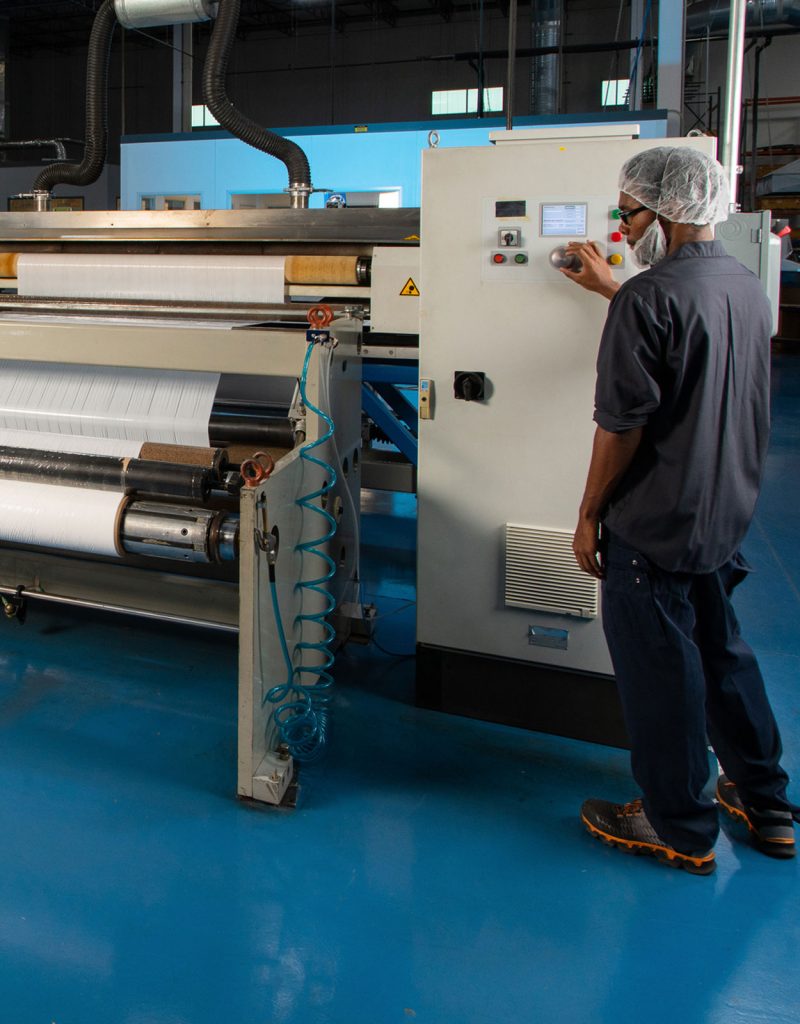
Needle Perforation
Hot needle
Hot needle perforation involves passing super-heated needles through the substrate to both penetrate and melt it in a predictable fashion. This results in a hole consistent in both size and shape.
Our state-of-the-art hot needle perforation features digital computer controls and servo drives for precise hole size. Potential pattern density can range from just one hole up to 1,000 per square inch. This makes Perftech’s hot needle perforation the optimal approach for applications requiring many perforations throughout the entire material.
Hot-needle holes typically range from 100 microns up to 1,500 microns (1/16″) depending on the tooling and the substrate being perforated. Perforations can be made either across the full roll width or in defined lanes. Because we toll-perforate for many different applications, we maintain a library of patterns that likely includes a tool set that will work for you. If your application requires a pattern not in our stock, we can manufacture a custom tool set that meets your needs.
Hot-needle perforation allows a poly-based material to be apertured with a hole that will not close. It is a perforation method of choice in applications where function is essential. The hole which is left by a hot perforation needle is re-enforced by a neat, molten ring of material that surrounds the hole. Hot needle perforation is used in a wide variety of applications.
Mechanical “cold needle”
Mechanical (or “cold needle”) perforation is similar to hot-needle perforation. It is more appropriate for applications that do not require the high consistency and control made possible by heated needles. Our mechanical perforation particularly suits industrial applications.
Mechanical perforation differs from hot-needle perforation in that with the absence of heat, the material is only pushed aside and not melted by the needle penetration. This results in the hole partially re-closing after perforation. This offers some advantages when trying to permit only one-way passage of a liquid or solid through the hole.
This technology is used in many applications and allows the substrate to be perforated with a raised surface on either side of the material. Perforations can be made in strips or in a continuous pattern across the web. Cold perforations can vary in size and can be made in many different patterns. The most common are square and diamond.
Common applications for Perftech’s needle perforation include:
- Food packaging: Vent excess air in bulk packages of frozen foods or pet foods.
- Fresh-cut produce and bakery: Allow undesirable surplus moisture and water to exit the package, resulting in shelf-life extension.
- Envelopes for super-absorbent meat pads The perforated poly film allows for the liquid to easily enter the meat pad while limiting its ability to exit thus maintaining freshness and promoting safe hygiene.
- Residential construction: Enable the passage of moisture but not liquid for radiant barriers and house wraps. Moisture-laden air generated in homes from a variety of sources travels upwards and must be able to pass through the radiant barrier to escape an attic.
- Perforated liners for weed block Perforated weed barriers have small pinprick holes that allow water and air through. They are an alternative to chemical pesticides and herbicides. Perforated weed control products safely and efficiently mitigate weed issues for both the home gardener and farmer.
- Sound management: Permit passage of sound waves through an otherwise barrier material into a sound-absorbing core. This reduces excess sound and reverberation. Applications include automotive and truck interiors, heavy equipment, as well as building interiors and wall board. It controls the amount of sound waves allowed through the material by variations of hole sizes and densities.
Let’s get started on your solution
Contact us at (630) 554-0010 today to discuss how Perftech’s large inventory of needle perforation patterns can solve your application’s permeation or barrier issue.



